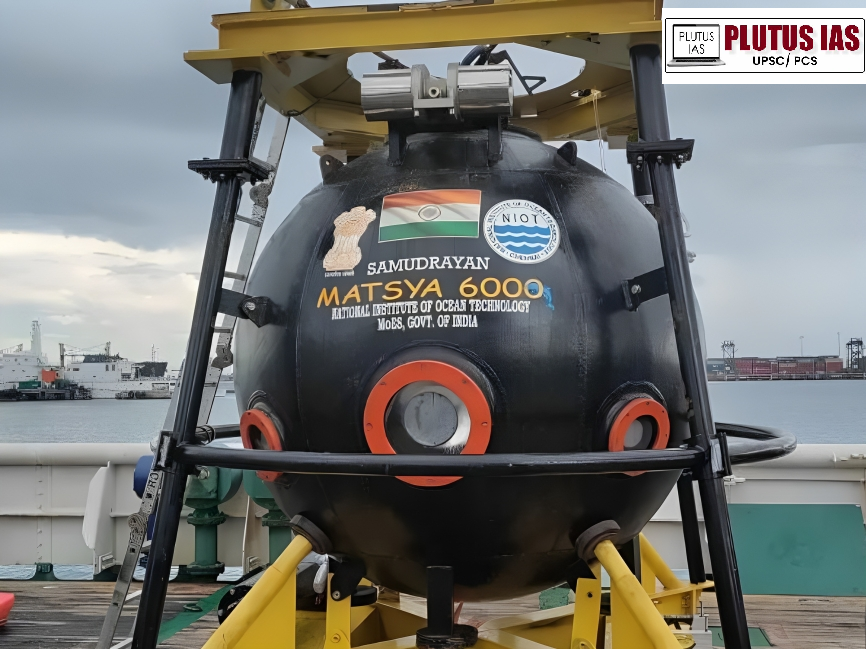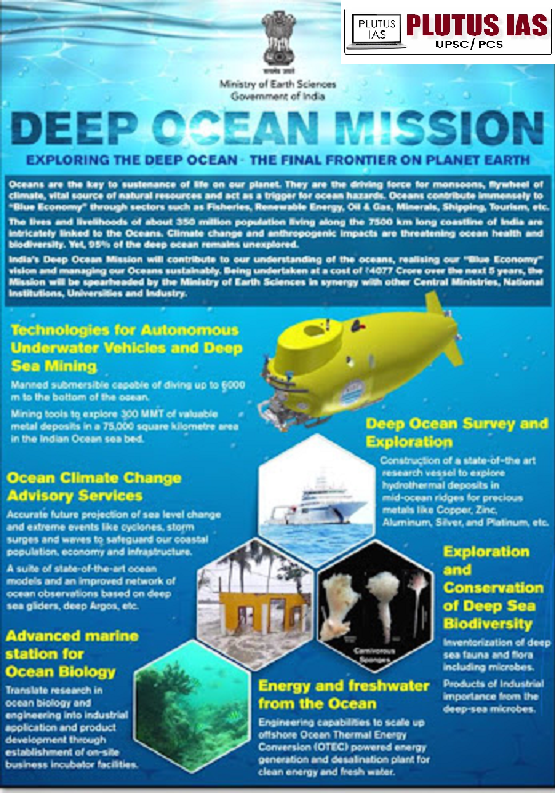24 Jan India’s Deep Ocean Mission Gains Momentum
SYLLABUS MAPPING:
GS-3-Science and Technology- India’s Deep Ocean Mission Gains Momentum
FOR PRELIMS:
What is Deep Ocean Mission and its components and mission?
FOR MAINS
What are the potential challenges and concerns related to deep-sea mining under the Deep Ocean Mission?
Why in the news?
India’s ambitious plan to launch its first human underwater submersible has been making headlines recently, as it marks a significant milestone in the country’s scientific and technological progress. Union Minister Dr Jitendra Singh announced that this submersible, which will initially operate at a depth of 500 meters and eventually reach up to 6,000 meters, positions India among just a few nations with the capability to undertake such an advanced underwater exploration mission. The announcement is part of India’s “Deep Ocean Mission” (DOM), a flagship initiative aimed at tapping into the vast resources of the ocean, including rare minerals and undiscovered marine biodiversity, which could boost the nation’s economic growth and sustainability efforts. The mission also aligns with India’s broader ambitions, such as the Gaganyaan space mission, showcasing the country’s growing capabilities in both space and ocean exploration.

Indian Deep Ocean Mission:
1. Launch Day:
Launch Date: The mission was formally approved in 2021 by the Cabinet Committee on Economic Affairs (CCEA). Specific details about the official launch day of individual components, such as the manned submersible, are still being planned, with the submersible’s deployment expected to occur in phases.
Phase 1 (2021-2024): The first phase of the mission focuses on foundational research, technology development, and pilot projects with an estimated budget of Rs. 2,823 crore.
2. Basic Facts:
Total Budget: The Deep Ocean Mission has a total estimated cost of Rs. 4,077 crore over a 5-year period (2021-2026).
Coastal Significance for India: India has a coastline of 7,517 km and is home to 9 coastal states and 1,382 islands. Approximately 30% of India’s population lives in coastal areas, making the ocean crucial for economic activities like fisheries, aquaculture, tourism, and maritime trade.
UN Decade of Ocean Science: The United Nations declared 2021-2030 as the Decade of Ocean Science for Sustainable Development, emphasizing the global importance of ocean exploration and sustainability.
Technological Innovation: The mission will focus on indigenizing deep-sea technologies that are currently not commercially available and will foster technological advancements through collaboration with institutions and private sectors.
International Seabed Authority:
| Aspect | Details |
|---|---|
| Established | 1994 under UNCLOS (1982) |
| Legal Foundation | Part XI of UNCLOS – Governs the international seabed as the “common heritage of all mankind” |
| Headquarters | Kingston, Jamaica |
| Membership | 167 member states and the European Union (EU) |
| Mission | Regulate seabed mineral exploration and exploitation; protect the marine environment |
| Key Governing Bodies | Assembly, Council, Secretary-General (Secretariat) |
| Primary Resource Focus | Polymetallic nodules in the Clarion-Clipperton Zone (Pacific Ocean) |
Objectives of Deep Ocean Mission:
1. Development of Deep-Sea Mining Technologies: Create technologies for mining deep-sea resources, such as Polymetallic nodules from the Central Indian Ocean at a depth of 5500 meters.
2. Design of Manned Submersible: Develop a working prototype and a final manned submersible capable of reaching 6000 meters depth, along with technologies for underwater vehicles and robotics.
3. Climate Change Projections: Provide predictions on trends in sea level, cyclone intensity, storm surges, wind waves, and impacts on fishery ecosystems in the North Indian Ocean under climate change scenarios.
4. Deep-Sea Biodiversity and DNA Bank: Conduct systematic sampling using Remotely Operated Vehicles (ROVs) to create a DNA bank and archive specimens of deep-sea fauna from the Northern Indian Ocean.
5. Microbial Research and Biomolecule Screening: Develop technologies to isolate piezotolerant and piezophilic microbes from the deep sea and screen for novel biomolecules through culture-based and metagenomic approaches.
6. Exploring Hydrothermal Sulphide Mineralization: Explore potential sites for multi-metal hydrothermal sulphides along the Indian Ocean’s mid-oceanic ridges for future resource exploitation.
7. Acquisition of Multidisciplinary Research Vessel: Acquire a new all-weather, multidisciplinary research vessel for operations in the Indian Ocean to support deep-ocean exploration and research.
8. Offshore OTEC Desalination and Marine Research Integration: Develop an engineering design for an offshore Ocean Thermal Energy Conversion (OTEC) powered desalination plant and integrate research in marine biology, ecology, and marine engineering through an advanced Marine Station for Ocean Biology.

Components of Deep Ocean Mission:
1. Manned Submersible & Deep-Sea Mining: Development of a manned submersible for 6000m depth and an Integrated Mining System for extracting Polymetallic Nodules from the Central Indian Ocean.
2. Ocean Climate Change Advisory: Creation of models and observations to predict climate variables like sea level rise and cyclone intensity on seasonal to decadal timescales.
3. Public Awareness: Promote knowledge about Earth system science and the achievements of the Ministry of Earth Sciences (MoES) among the public and academic communities.
4. Deep-Sea Biodiversity Innovation: Focus on bio-prospecting deep-sea species and microbes for sustainable use and resource conservation.
5. Deep Ocean Survey: Identify sites for multi-metal hydrothermal sulphides along the Indian Ocean mid-oceanic ridges.
6. Ocean Energy & Freshwater: Design an OTEC-powered desalination plant for offshore energy generation and freshwater production.
7. Marine Biology Station: Establish an advanced research station for ocean biology to foster industrial applications and start-up innovations.
8. Blue Economy Support: Drive initiatives in marine fisheries, coastal tourism, offshore energy, and marine biology through mission components.
Significance of Deep Ocean Mission:
1. Advancing Science: Enhances understanding of deep-ocean ecosystems and biodiversity.
2. Resource Exploration: Supports the exploration of deep-sea minerals like Polymetallic Nodules for future resource needs.
3. Blue Economy Growth: Boosts sustainable use of ocean resources in sectors like fisheries, biotechnology, and offshore energy.
4. Climate Change Research: Provides critical data for understanding and mitigating the impacts of climate change, especially in coastal areas.
5. Technological Innovation: Develop advanced technologies such as manned submersibles and desalination plants.
6. Conservation: Promotes sustainable use and conservation of deep-sea biodiversity.
7. Global Leadership: Positions India as a leader in marine science and ocean governance.
8. Economic Growth: Generates jobs, fosters technological advancements, and supports India’s blue economy.
Concern Regarding Deep Ocean Mission:
1. Environmental Impact: Deep-sea mining and exploration could harm fragile ecosystems and biodiversity.
2. Sustainability: Resource extraction, like mining Polymetallic Nodules, may not be sustainable long-term.
3. Technology and Safety: Operating submersibles and robots at 6000m depth present safety and equipment challenges.
4. Regulatory Oversight: Concerns about international regulations for managing deep-sea activities and preventing environmental harm.
5. Ethical Issues: Exploitation: Deep-sea species for commercial use raises ethical concerns.
6. Climate Change: Deep-sea operations could unintentionally disrupt oceanic carbon sinks.
7. Cost and Funding: High financial costs for technology development and environmental monitoring may strain resources.
Way to make Deep Ocean Mission sustainable:
1. Environmental Safeguards: Establish strict environmental monitoring and impact assessments to minimize damage to ocean ecosystems, including biodiversity protection and habitat conservation.
2. Regulation and Governance: Strengthen collaboration with international bodies like the International Seabed Authority (ISA) to ensure that deep-sea mining and exploration activities follow responsible and sustainable practices.
3. Technological Innovation: Focus on developing eco-friendly technologies for mining, exploration, and resource extraction that reduce environmental footprints, such as non-invasive mining methods and sustainable energy solutions.
4. Circular Economy: Promote a circular economy approach by ensuring that resources extracted are used efficiently and waste is minimized or recycled, reducing overall environmental impact.
5. Biodiversity Conservation: Prioritize bio-prospecting and research on deep-sea species in a way that ensures sustainable use of marine life and maintains ecosystem balance.
6. Scientific Collaboration: Foster partnerships with global scientific communities to share data, expertise, and resources, ensuring best practices are followed and minimizing risks to marine environments.
7. Sustainable Resource Management: Set up clear limits on the amount of minerals that can be extracted and ensure that resources are used for long-term benefits rather than short-term exploitation.
8. Community and Stakeholder Engagement: Engage with local coastal communities and other stakeholders to understand their concerns, share knowledge, and ensure the benefits of the mission are equitably distributed.
Download Plutus IAS Current Affairs (Eng) 24th Jan 2025
Conclusions:
The Deep Ocean Mission (DOM) represents a significant leap forward in India’s scientific and technological capabilities, aiming to tap into the vast resources of the ocean for sustainable economic growth. By developing cutting-edge technologies such as manned submersibles and deep-sea mining systems, India is positioning itself as a global leader in marine science and ocean governance. The mission aligns with broader national goals like the Blue Economy, supporting sectors like fisheries, offshore energy, and biotechnology. While the mission holds immense potential for economic growth and environmental sustainability, it also brings concerns regarding environmental impact, resource sustainability, and regulatory oversight.
Prelims Question:
Q. With reference to the Deep Ocean Mission (DOM), which of the following is/are correct?
1. The mission aims to develop a manned submersible capable of reaching depths of 6,000 meters.
2. The mission’s total budget is estimated at Rs. 4,077 crore for a 10-year period.
Select the correct answer using the code given below:
A. 1 only
B. 2 only
C. Both 1 and 2
D. Neither 1 nor 2
Answer: A
Mains Question:
(250 words, 15 marks)




No Comments